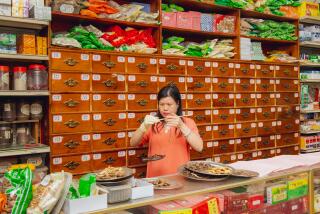Ginseng Makes a Great Tonic for Economy : Crops: The gnarled root is a prized product in Canada, which exports it to Asia. It is used in holistic medicine.
- Share via
VANCOUVER, Canada — Where the craggy peaks of the Rocky Mountains give way to rugged arid valleys in Canada’s westernmost province, the most valuable legal crop in the world sprouts from the earth.
It’s ginseng, a gnarled root prized in traditional Asian medicine and more profitable than any other plant aside from illicit drugs, according to growers and government data. Although people generally associate ginseng with the Far East, it’s becoming big business in western Canada.
In fact, companies based in British Columbia have become some of the biggest individual commercial producers in the $2-billion-a-year worldwide ginseng trade, which has historically been dominated by small family farms.
The lure of riches is increasingly prompting farmers in the prime growing area of the Okanagan Valley in southeastern British Columbia to turn their land over to ginseng.
“It’s booming,” said Gerry Gill, president of Chai-Na-Ta Corp., a leading grower.
Based outside Vancouver, Chai-Na-Ta sparked the Canadian ginseng craze and claims to be the world’s biggest single corporate grower, with 1,400 acres under cultivation.
Vancouver-based Canadian Imperial Ginseng Products Ltd., which went public only last February, is newer on the scene but believes it may already be the world’s second biggest ginseng company.
Both companies say it is impossible to know their rankings for sure because data for state farms and collectives in China and Korea, major ginseng producers, are scarce.
But they have no doubts about ginseng’s profitability.
“When you grow marijuana, you go to jail. When you grow ginseng, you go to the bank,” joked Maurice Levesque, a spokesman for Canadian Imperial.
Skeptics only have to travel as far as Vancouver’s Chinatown for proof. At the Teck Shun herb shop, ginseng jars line the shelves, but the place of honor goes to a box of the root that sells for a hefty $4,400 an ounce.
Business is brisk, although customers usually buy cheaper varieties that can sell for as little as $7.40 an ounce. “Ginseng can give you health. It’s very popular,” said owner George Chan.
Chai-Na-Ta estimates that an acre of ginseng generates gross revenues of up to $92,600. That compares to $18,500 for kiwi fruit, its closest rival, and $385 for lowly alfalfa, government data show. Profit margins for ginseng are around 60%, analysts calculate.
“There’s nothing else like it. Other crops don’t even come close,” said investment analyst Jennifer Tai of brokers Brink, Hudson & Lefever Ltd who has studied ginseng.
Canadians began experimenting with ginseng in the early 1980s after Chai-Na-Ta’s founder attended a ginseng auction during a business trip to Hong Kong where one rare root sold for more than $65,000.
Virtually all the Canadian production is exported to Asia, usually passing through the hands of Hong Kong brokers who then sell it in China, Singapore and Taiwan.
Ginseng has been used in Chinese holistic medicine for more than 2,000 years and at times has been more valuable than gold. The Canadian producers grow what’s known as North American ginseng, one of two commercially cultivated types.
Prized for its soothing properties, North American ginseng accounts for about one-fifth of the world market of 6,500 metric tons while the main Asian strain, known for its energizing effects, accounts for the rest.
Demand for North American ginseng is forecast to rise because it is perceived as a premium product. Also its reputation as a calming agent is expected to boost consumption as lifestyles in Asia become increasingly hectic.
Traditionally users make a tonic of ginseng by steeping slices of the root in water or broth. But Canadian growers are increasingly focusing on developing value-added products like ginseng teas and capsules. They are also hoping to expand consumption in Europe and North America.
Tai forecasts that Canada’s wholesale ginseng exports will hit $148 million by 1996 from $24 million last year. Canadian producers are currently fetching about $24.40 a pound for their ginseng at the farm level and the mark-up at the retail level is about 12 times that, analysts say.
But the price is down from more than $30 last year, and analysts fear that prices could fall further as production rises. These worries have been keeping Chai-Na-Ta’s and Canadian Imperial’s stock prices in the doldrums.
“A lot of people have gotten into ginseng, but no one really knows how much the market can absorb. It’s still a risky crop from a cultivation and marketing point of view,” said Gretchen Bozak, a specialist at Agriculture Canada.
British Columbia’s interior has an advantage over other areas where North American ginseng is grown--notably the Canadian province of Ontario and Wisconsin--because the weather is drier and growing conditions are easier to control. This is crucial because it takes four years for a ginseng crop to mature.
More to Read
Inside the business of entertainment
The Wide Shot brings you news, analysis and insights on everything from streaming wars to production — and what it all means for the future.
You may occasionally receive promotional content from the Los Angeles Times.










